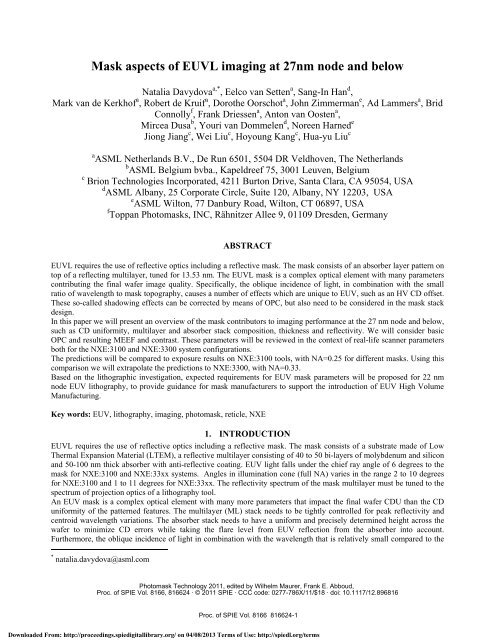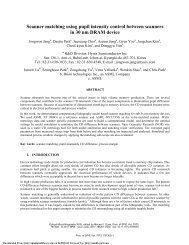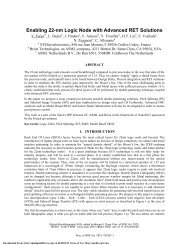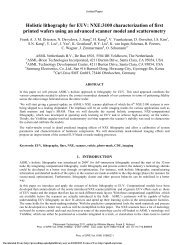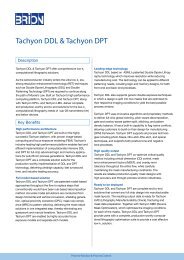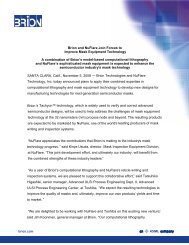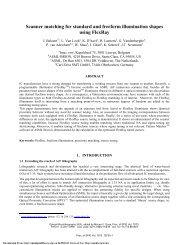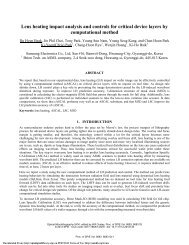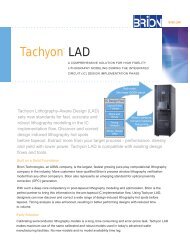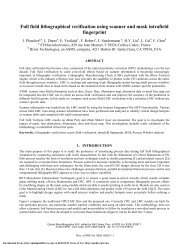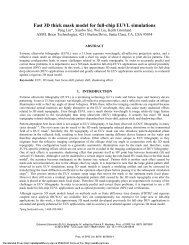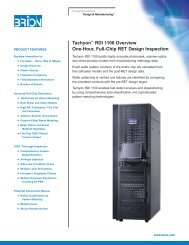Mask aspects of EUVL imaging at 27nm node and below
Mask aspects of EUVL imaging at 27nm node and below - Brion ...
Mask aspects of EUVL imaging at 27nm node and below - Brion ...
- No tags were found...
Create successful ePaper yourself
Turn your PDF publications into a flip-book with our unique Google optimized e-Paper software.
<strong>Mask</strong> <strong>aspects</strong> <strong>of</strong> <strong>EUVL</strong> <strong>imaging</strong> <strong>at</strong> <strong>27nm</strong> <strong>node</strong> <strong>and</strong> <strong>below</strong><br />
N<strong>at</strong>alia Davydova a,* , Eelco van Setten a , Sang-In Han d ,<br />
Mark van de Kerkh<strong>of</strong> a , Robert de Kruif a , Dorothe Oorschot a , John Zimmerman e , Ad Lammers a , Brid<br />
Connolly f , Frank Driessen a , Anton van Oosten a ,<br />
Mircea Dusa b , Youri van Dommelen d , Noreen Harned e<br />
Jiong Jiang c , Wei Liu c , Hoyoung Kang c , Hua-yu Liu c<br />
a ASML Netherl<strong>and</strong>s B.V., De Run 6501, 5504 DR Veldhoven, The Netherl<strong>and</strong>s<br />
b ASML Belgium bvba., Kapeldreef 75, 3001 Leuven, Belgium<br />
c Brion Technologies Incorpor<strong>at</strong>ed, 4211 Burton Drive, Santa Clara, CA 95054, USA<br />
d ASML Albany, 25 Corpor<strong>at</strong>e Circle, Suite 120, Albany, NY 12203, USA<br />
e ASML Wilton, 77 Danbury Road, Wilton, CT 06897, USA<br />
f Toppan Photomasks, INC, Rähnitzer Allee 9, 01109 Dresden, Germany<br />
ABSTRACT<br />
<strong>EUVL</strong> requires the use <strong>of</strong> reflective optics including a reflective mask. The mask consists <strong>of</strong> an absorber layer p<strong>at</strong>tern on<br />
top <strong>of</strong> a reflecting multilayer, tuned for 13.53 nm. The <strong>EUVL</strong> mask is a complex optical element with many parameters<br />
contributing the final wafer image quality. Specifically, the oblique incidence <strong>of</strong> light, in combin<strong>at</strong>ion with the small<br />
r<strong>at</strong>io <strong>of</strong> wavelength to mask topography, causes a number <strong>of</strong> effects which are unique to EUV, such as an HV CD <strong>of</strong>fset.<br />
These so-called shadowing effects can be corrected by means <strong>of</strong> OPC, but also need to be considered in the mask stack<br />
design.<br />
In this paper we will present an overview <strong>of</strong> the mask contributors to <strong>imaging</strong> performance <strong>at</strong> the 27 nm <strong>node</strong> <strong>and</strong> <strong>below</strong>,<br />
such as CD uniformity, multilayer <strong>and</strong> absorber stack composition, thickness <strong>and</strong> reflectivity. We will consider basic<br />
OPC <strong>and</strong> resulting MEEF <strong>and</strong> contrast. These parameters will be reviewed in the context <strong>of</strong> real-life scanner parameters<br />
both for the NXE:3100 <strong>and</strong> NXE:3300 system configur<strong>at</strong>ions.<br />
The predictions will be compared to exposure results on NXE:3100 tools, with NA=0.25 for different masks. Using this<br />
comparison we will extrapol<strong>at</strong>e the predictions to NXE:3300, with NA=0.33.<br />
Based on the lithographic investig<strong>at</strong>ion, expected requirements for EUV mask parameters will be proposed for 22 nm<br />
<strong>node</strong> EUV lithography, to provide guidance for mask manufacturers to support the introduction <strong>of</strong> EUV High Volume<br />
Manufacturing.<br />
Key words: EUV, lithography, <strong>imaging</strong>, photomask, reticle, NXE<br />
1. INTRODUCTION<br />
<strong>EUVL</strong> requires the use <strong>of</strong> reflective optics including a reflective mask. The mask consists <strong>of</strong> a substr<strong>at</strong>e made <strong>of</strong> Low<br />
Thermal Expansion M<strong>at</strong>erial (LTEM), a reflective multilayer consisting <strong>of</strong> 40 to 50 bi-layers <strong>of</strong> molybdenum <strong>and</strong> silicon<br />
<strong>and</strong> 50-100 nm thick absorber with anti-reflective co<strong>at</strong>ing. EUV light falls under the chief ray angle <strong>of</strong> 6 degrees to the<br />
mask for NXE:3100 <strong>and</strong> NXE:33xx systems. Angles in illumin<strong>at</strong>ion cone (full NA) varies in the range 2 to 10 degrees<br />
for NXE:3100 <strong>and</strong> 1 to 11 degrees for NXE:33xx. The reflectivity spectrum <strong>of</strong> the mask multilayer must be tuned to the<br />
spectrum <strong>of</strong> projection optics <strong>of</strong> a lithography tool.<br />
An EUV mask is a complex optical element with many more parameters th<strong>at</strong> impact the final wafer CDU than the CD<br />
uniformity <strong>of</strong> the p<strong>at</strong>terned fe<strong>at</strong>ures. The multilayer (ML) stack needs to be tightly controlled for peak reflectivity <strong>and</strong><br />
centroid wavelength vari<strong>at</strong>ions. The absorber stack needs to have a uniform <strong>and</strong> precisely determined height across the<br />
wafer to minimize CD errors while taking the flare level from EUV reflection from the absorber into account.<br />
Furthermore, the oblique incidence <strong>of</strong> light in combin<strong>at</strong>ion with the wavelength th<strong>at</strong> is rel<strong>at</strong>ively small compared to the<br />
* n<strong>at</strong>alia.davydova@asml.com<br />
Photomask Technology 2011, edited by Wilhelm Maurer, Frank E. Abboud,<br />
Proc. <strong>of</strong> SPIE Vol. 8166, 816624 · © 2011 SPIE · CCC code: 0277-786X/11/$18 · doi: 10.1117/12.896816<br />
Proc. <strong>of</strong> SPIE Vol. 8166 816624-1<br />
Downloaded From: http://proceedings.spiedigitallibrary.org/ on 04/08/2013 Terms <strong>of</strong> Use: http://spiedl.org/terms
mask topography causes a number <strong>of</strong> effects which are unique to EUV, such as an HV CD <strong>of</strong>fset <strong>and</strong> an orient<strong>at</strong>ion<br />
dependent p<strong>at</strong>tern placement error. These so-called shadowing effects can be corrected by means <strong>of</strong> OPC, but also need<br />
to be considered in the mask stack design. The <strong>imaging</strong> performance (Exposure L<strong>at</strong>itude, <strong>Mask</strong> Error Enhancement<br />
Factor) can be optimized by an integral approach, taking the absorber thickness <strong>and</strong> mask bias into account.<br />
In this paper we will look into the impact <strong>of</strong> multilayer performance on <strong>imaging</strong> in terms <strong>of</strong> centroid wavelength tuning,<br />
absorber height <strong>and</strong> bias impact on <strong>imaging</strong> for 27 nm dense L/S in resist by means <strong>of</strong> wafers exposed on NXE:3100.<br />
Rigorous simul<strong>at</strong>ions are performed to evalu<strong>at</strong>e the possibilities for mask stack optimiz<strong>at</strong>ion for the NXE:3300 with 22<br />
nm <strong>node</strong>. Furthermore, we will look <strong>at</strong> the impact <strong>of</strong> EUV absorber reflectivity on CD uniformity due to image border<br />
reflections <strong>at</strong> the edges <strong>of</strong> the field <strong>and</strong> possible correction methods by means <strong>of</strong> mask OPC.<br />
2. MULTILAYER CENTROID WAVELENGTH OPTIMIZATION<br />
Multilayer is characterized by its reflectivity spectrum through EUV wavelength for different angles <strong>of</strong> incidence (AOI)<br />
to the mask. On Figure 1 a measured reflectivity spectrum <strong>of</strong> a multilayer is shown for AOI <strong>of</strong> 6 degrees characterized by<br />
centroid wavelength, peak reflectivity <strong>and</strong> full width <strong>at</strong> half maximum. This spectrum was also successfully simul<strong>at</strong>ed in<br />
KLA-Tencor ProLith 3.2 s<strong>of</strong>tware using a rigorous Maxwell model <strong>and</strong> a detailed stack.<br />
Reflectivity<br />
70%<br />
60%<br />
50%<br />
40%<br />
30%<br />
20%<br />
10%<br />
Simul<strong>at</strong>ed ML<br />
reflectivity<br />
Measured ML<br />
reflectivity<br />
Centroid<br />
Wavelength<br />
~13.53 nm<br />
Peak<br />
Reflectivity<br />
~ 65%<br />
FWHM<br />
~0.5 nm<br />
0%<br />
12.5 13 13.5 14<br />
Wavelength, nm<br />
Figure 1 A measured <strong>and</strong> simul<strong>at</strong>ed multilayer reflectivity spectrum characterized by centroid wavelength, peak reflectivity <strong>and</strong> full<br />
width <strong>at</strong> half maximum (FWHM).<br />
A multilayer stack with 40-layers was optimized in order to m<strong>at</strong>ch peak reflectivity <strong>and</strong> full width <strong>at</strong> half maximum<br />
(FWHM) <strong>of</strong> a measured multilayer reflectivity spectrum (centroid wavelength can be easily m<strong>at</strong>ched by scaling <strong>of</strong> the<br />
ML stack thickness - see <strong>below</strong>). For this purpose thicknesses <strong>of</strong> two MoSi 2 intermixing layers were optimized. The<br />
resulting ML stack has the following thicknesses: 2.497 nm Si, 0.799 nm MoSi 2 , 1.897 nm Mo <strong>and</strong> 1.837 nm MoSi 2 with<br />
the total ML period <strong>of</strong> 7.03 nm. The accuracy <strong>of</strong> the m<strong>at</strong>ching was 0.26% for peak reflectivity <strong>and</strong> 0.0002 nm for<br />
FWHM. The usage <strong>of</strong> the intermixing layers in simul<strong>at</strong>ion seems to be unavoidable because otherwise peak reflectivity<br />
<strong>and</strong> FWHM <strong>of</strong> the spectrum are largely overestim<strong>at</strong>ed. The actual presence <strong>of</strong> the MoSi 2 intermixing layers was<br />
demonstr<strong>at</strong>ed in [1] by means <strong>of</strong> transmission electron spectroscopy (XTEM) showing the intermixing layers with<br />
thickness <strong>of</strong> 0.6 nm on Mo top <strong>and</strong> 1.7 nm on Si top with the full ML period <strong>of</strong> 6.95 nm <strong>and</strong> Mo/Si r<strong>at</strong>io <strong>of</strong> 0.4. Notice<br />
th<strong>at</strong> in our simul<strong>at</strong>ion we have kept the r<strong>at</strong>ios between the layers thickness close to these experimental values, while the<br />
total ML period was 1.5% increased in order to m<strong>at</strong>ch the centroid wavelength.<br />
If angle <strong>of</strong> incidence to the mask or ML stack thickness vary, the reflectivity spectrum change <strong>and</strong>, in particular, the<br />
centroid wavelength is shifted. This shift was simul<strong>at</strong>ed using the calibr<strong>at</strong>ed ML stack described above (Figure 2). The<br />
centroid wavelength grows linearly as a function <strong>of</strong> ML stack thickness <strong>and</strong> decreases quadr<strong>at</strong>ically through the angle <strong>of</strong><br />
incidence. This can be understood from a thin film interference approxim<strong>at</strong>ion. Peak (<strong>and</strong> centroid) wavelength are<br />
determined by an optical p<strong>at</strong>h difference (OPD) corresponding to constructive interference. OPD is described by the<br />
following equ<strong>at</strong>ion:<br />
Proc. <strong>of</strong> SPIE Vol. 8166 816624-2<br />
Downloaded From: http://proceedings.spiedigitallibrary.org/ on 04/08/2013 Terms <strong>of</strong> Use: http://spiedl.org/terms
2<br />
⎛ n ⎞<br />
⎛ ⎞<br />
1 2<br />
θ<br />
= = −<br />
⎜<br />
⎟ ≈ ⎜ ⎟<br />
−<br />
1<br />
OPD 2n2d<br />
cosθ 2<br />
2n2d<br />
1 sin θ1<br />
2n2d<br />
1 .<br />
2<br />
⎝ n2<br />
⎠<br />
⎝ 2n2<br />
⎠<br />
We assumed th<strong>at</strong> incident angle θ 1 <strong>and</strong> refracted angle θ 2 are small. Refractive index n 1 <strong>of</strong> vacuum is 1 while n 2 is an<br />
effective refractive index for multilayer which is estim<strong>at</strong>ed to be 0.965 (from the slopes <strong>of</strong> simul<strong>at</strong>ed curves) close to the<br />
refractive index <strong>of</strong> MoSi 2 (0.969).<br />
2<br />
ML centroid wavelength, nm<br />
13.9<br />
13.8<br />
13.7<br />
13.6<br />
13.5<br />
13.4<br />
13.3<br />
Angle <strong>of</strong> Incidence<br />
1 degree<br />
6 degrees<br />
11 degrees<br />
CTW50, nm<br />
13.8<br />
13.7<br />
13.6<br />
13.5<br />
13.4<br />
13.3<br />
13.2<br />
13.1<br />
ML thickness<br />
-1.0%<br />
0.0%<br />
1.0%<br />
13.2<br />
-1.0% -0.5% 0.0% 0.5% 1.0%<br />
ML thickness vari<strong>at</strong>ion<br />
13<br />
0 2 4 6 8 10 12 14 16<br />
AOI, degrees<br />
Figure 2 The centroid wavelength <strong>of</strong> ML reflectivity spectrum depends linearly on the ML stack thickness (left) <strong>and</strong> quadr<strong>at</strong>ically on<br />
the angle <strong>of</strong> incidence (right).<br />
Having the linear rel<strong>at</strong>ion between ML thickness <strong>and</strong> the centroid wavelength, we can easily vary the l<strong>at</strong>ter in simul<strong>at</strong>ion<br />
by changing the ML thickness / period while keeping r<strong>at</strong>ios between the monolayers (gamma) constant. The ML is then<br />
fully described by its nominal centroid wavelength ctw50 <strong>at</strong> the AOI <strong>of</strong> 6 degrees. For all simul<strong>at</strong>ions further ML with<br />
the period <strong>of</strong> 7.03 nm is used with the nominal ctw50 <strong>of</strong> 13.53 nm corresponding to a specific<strong>at</strong>ion in ASML reticle<br />
manual.<br />
Illumin<strong>at</strong>ion in a EUV scanner has a certain b<strong>and</strong>width which must be taken into account in mask reflectivity<br />
calcul<strong>at</strong>ions <strong>and</strong> <strong>imaging</strong> simul<strong>at</strong>ions. We will consider broad b<strong>and</strong> ML reflectivity which is a convolution <strong>of</strong> scanner<br />
optics spectrum <strong>and</strong> ML spectrum as illustr<strong>at</strong>ed in Figure 3. Here the green curve represents ML reflectivity, the blue<br />
curve is a rel<strong>at</strong>ive spectrum <strong>of</strong> the scanner optics (normalized to unit integral power) <strong>and</strong> the blue area is the convolution<br />
representing the broad b<strong>and</strong> ML reflectivity.<br />
Figure 3 Broad b<strong>and</strong> reflectivity <strong>of</strong> mask multilayer is a convolution <strong>of</strong> ML reflectivity spectrum <strong>and</strong> scanner source <strong>and</strong> optics<br />
spectrum.<br />
The broad b<strong>and</strong> mask reflectivity depends on illumin<strong>at</strong>ion angle. It can be represented as a map in the pupil plane as<br />
shown in Figure 4 (see also [2] ). Average broad b<strong>and</strong> reflectivity over the angles <strong>of</strong> incidence is determined by the<br />
particular illumin<strong>at</strong>ion type.<br />
Proc. <strong>of</strong> SPIE Vol. 8166 816624-3<br />
Downloaded From: http://proceedings.spiedigitallibrary.org/ on 04/08/2013 Terms <strong>of</strong> Use: http://spiedl.org/terms
Figure 4 ML broad b<strong>and</strong> reflectivity depends on light incidence angle (left). This is represented as a map in the pupil plane (middle).<br />
Average broad b<strong>and</strong> reflectivity depends on illumin<strong>at</strong>ion type (right).<br />
If the mask is detuned rel<strong>at</strong>ive to the scanner optics, the average broad b<strong>and</strong> reflectivity drops. In addition, the range <strong>of</strong><br />
reflectivity vari<strong>at</strong>ion over the angles <strong>of</strong> incidence increases. This effect is called mask induced apodiz<strong>at</strong>ion which is<br />
defined as a range <strong>of</strong> the reflectivity vari<strong>at</strong>ion normalized to maximal broad b<strong>and</strong> reflectivity. Figure 5 illustr<strong>at</strong>es<br />
dependence <strong>of</strong> the broadb<strong>and</strong> reflectivity <strong>and</strong> the apodiz<strong>at</strong>ion on the mask centroid wavelength.<br />
Figure 5 If the mask centroid wavelength is detuned w.r.t. the scanner optics, the average broad b<strong>and</strong> reflectivity drops <strong>and</strong><br />
apodiz<strong>at</strong>ion increases.<br />
There is a near quadr<strong>at</strong>ic dependence <strong>of</strong> the average broad b<strong>and</strong> reflectivity on the centroid wavelength as shown on<br />
Figure 6 (left). Therefore the reflectivity reaches maximum <strong>at</strong> a certain optimal wavelength, <strong>and</strong> also the sensitivity <strong>of</strong><br />
reflectivity to the centroid wavelength <strong>and</strong> ML thickness vari<strong>at</strong>ions over the blank is minimized <strong>at</strong> this wavelength. An<br />
average optimal centroid wavelength for different illumin<strong>at</strong>ion types is calcul<strong>at</strong>ed to be 13.52 nm for the maximal<br />
reflectivity metrics with ±0.01 nm range for different illumin<strong>at</strong>ion types. The reflectivity vari<strong>at</strong>ion over the blank can be<br />
directly transl<strong>at</strong>ed in the dose <strong>and</strong> CD vari<strong>at</strong>ion (Figure 7, left).<br />
Proc. <strong>of</strong> SPIE Vol. 8166 816624-4<br />
Downloaded From: http://proceedings.spiedigitallibrary.org/ on 04/08/2013 Terms <strong>of</strong> Use: http://spiedl.org/terms
Average Broad B<strong>and</strong> Reflectivity [%]<br />
63<br />
62<br />
61<br />
60<br />
59<br />
58<br />
57<br />
56<br />
55<br />
54<br />
53<br />
13.4 13.45 13.5 13.55 13.6 13.65 13.7<br />
<strong>Mask</strong> CTW50 [nm]<br />
Full NA Mean<br />
Conv. s = 0.2-0.9<br />
Mean<br />
Ann. s = 0.65/ 0.9<br />
Mean<br />
Low Sigma= 0.2-<br />
0.65 Mean<br />
Dip_X-90 s = 0.2 /<br />
0.9 Mean<br />
Dip_Y-90 s = 0.2 /<br />
0.9 Mean<br />
Quasar_45 = 0.2-<br />
0.9 Mean<br />
C_Quad_45 = 0.2-<br />
0.9 Mean<br />
Apodiz<strong>at</strong>ion, %<br />
50<br />
45<br />
40<br />
35<br />
30<br />
25<br />
20<br />
15<br />
10<br />
5<br />
0<br />
13.4 13.45 13.5 13.55 13.6 13.65 13.7<br />
<strong>Mask</strong> ctw50, nm<br />
Full NA<br />
Conv. s =<br />
0.2-0.9<br />
Ann. s =<br />
0.65/ 0.9<br />
Low Sigma=<br />
0.2-0.65<br />
Dip_X-90 s<br />
= 0.2 / 0.9<br />
Dip_Y-90 s<br />
= 0.2 / 0.9<br />
Quasar_45<br />
= 0.2-0.9<br />
C_Quad_45<br />
= 0.2-0.9<br />
Figure 6 Broad b<strong>and</strong> reflectivity (left) <strong>and</strong> apodiz<strong>at</strong>ion (right) have an optimal centroid wavelength.<br />
The centroid wavelength can also be optimized based on apodiz<strong>at</strong>ion minimiz<strong>at</strong>ion as shown on Figure 6 (right). The<br />
average optimal ctw50 is 13.54±0.01 in this case. Ctw50 vari<strong>at</strong>ions over the blank are specified to be ±0.02 nm th<strong>at</strong><br />
corresponds to maximal apodiz<strong>at</strong>ion <strong>of</strong> 17.2%. Notice th<strong>at</strong> 22 nm <strong>node</strong> specific<strong>at</strong>ions can support up to 30% apodiz<strong>at</strong>ion.<br />
The apodiz<strong>at</strong>ion leads to diffraction orders imbalance th<strong>at</strong> results in mask induced telecentricity errors <strong>and</strong> p<strong>at</strong>tern<br />
displacement (Figure 7, right).<br />
CD error, nm<br />
2<br />
1<br />
0<br />
CD error due to +/- 0.1% ML thickness change<br />
Optimal CTW50 is 13.54 nm<br />
-1<br />
NA=0.25 27 V dense<br />
-2<br />
NA=0.25 27 H dense<br />
-3<br />
NA=0.25 27 H iso<br />
NA=0.33 16 H dense DipY90<br />
-4<br />
13.4 13.45 13.5 13.55<br />
CTW50, nm<br />
13.6 13.65<br />
Telecentricity, mrad<br />
6<br />
2<br />
-2<br />
-6<br />
-10<br />
-14<br />
-18<br />
Non-telecentricity grows if mask is detuned<br />
Very large effect for 16 nm <strong>node</strong><br />
NA=0.25 27 V dense<br />
NA=0.25 27 H dense<br />
NA=0.25 27 H iso<br />
-22<br />
NA=0.33 16 H dense DipY90<br />
13.37 13.47 13.57 13.67<br />
CTW50, nm<br />
Figure 7 Reflectivity vari<strong>at</strong>ion through the blank results in CD non-uniformity if ctw50 is detuned (left). The apodiz<strong>at</strong>ion results in<br />
diffraction order imbalance <strong>and</strong> telecentricity errors (right).<br />
The simul<strong>at</strong>ion results shown on Figure 7 are performed for a single exposure wavelength <strong>and</strong> therefore preliminary.<br />
More detailed simul<strong>at</strong>ions <strong>of</strong> these <strong>imaging</strong> <strong>and</strong> overlay effects for 22 nm <strong>node</strong> <strong>and</strong> <strong>below</strong> will be performed.<br />
3. ABSORBER OPTIMIZATION<br />
EUV mask absorber has three dimensions: height, vertical <strong>and</strong> horizontal fe<strong>at</strong>ure bias. All three dimensions can be<br />
optimized together to reach optimal <strong>imaging</strong> performance in contrast <strong>and</strong> exposure l<strong>at</strong>itude. The exposure l<strong>at</strong>itude has a<br />
global maximum in absorber height vs. bias space [3] . This global maximum depends on illumin<strong>at</strong>ion setting. It was also<br />
shown by means <strong>of</strong> simul<strong>at</strong>ions th<strong>at</strong> thicker absorbers perform better for larger angular distribution NAσ <strong>of</strong> illumin<strong>at</strong>ion<br />
light for 27 nm <strong>node</strong>.<br />
This result is confirmed by new simul<strong>at</strong>ions using the calibr<strong>at</strong>ed ML stack. The simul<strong>at</strong>ions are performed for 27 nm<br />
dense lines for three illumin<strong>at</strong>ion settings: NA=0.25 / σ=0.5, NA=0.25 / σ=0.8 <strong>and</strong> NA=0.33 / σ=0.9/0.2. The results are<br />
shown in Figure 8 (left column). We see th<strong>at</strong> for broader illumin<strong>at</strong>ion EL maximum is shifted towards thicker absorber<br />
<strong>and</strong> larger biases.<br />
Proc. <strong>of</strong> SPIE Vol. 8166 816624-5<br />
Downloaded From: http://proceedings.spiedigitallibrary.org/ on 04/08/2013 Terms <strong>of</strong> Use: http://spiedl.org/terms
NA=0.25 / σ=0.5<br />
NA=0.25 / σ=0.8<br />
NA=0.33 / σ=0.9/0.2<br />
Figure 8 Exposure l<strong>at</strong>itude has a global maximum in Absorber height vs. Bias space. This maximum is shifted towards thicker<br />
absorbers <strong>and</strong> larger biases for broader illumin<strong>at</strong>ion settings NAσ for 27 nm <strong>node</strong> (left column, from top to bottom). The optimal<br />
absorber thickness is smaller for 22 nm lines than for 27 nm (bottom row).<br />
For NA=0.33 / σ=0.9/0.2, exposure l<strong>at</strong>itude <strong>of</strong> 22 nm dense lines was also calcul<strong>at</strong>ed (Figure 8, bottom right).The<br />
optimal absorber thickness becomes smaller for 22 nm <strong>node</strong> compared to 27 nm. Notice th<strong>at</strong> the same full physical resist<br />
model is used in both cases for the comparison reason, while on practice a resist with a smaller diffusion length will<br />
presumably be used for 22 nm <strong>imaging</strong>.<br />
The summary <strong>of</strong> the simul<strong>at</strong>ions is shown in Figure 9. The global absorber height <strong>and</strong> HV bias is shown for all cases.<br />
On practice there is no need to go to this global maximum for an acceptable <strong>imaging</strong> performance because the usage <strong>of</strong><br />
thick absorber requires also higher exposure dose [3] . But the values <strong>and</strong> trends show clearly th<strong>at</strong> there is no urgent need<br />
to go to smaller absorber height for 22 nm <strong>imaging</strong>, though HV shadowing bias compens<strong>at</strong>ion on mask in case <strong>of</strong> thick<br />
absorber is a requirement.<br />
Absorber height, nm<br />
120<br />
100<br />
80<br />
60<br />
40<br />
20<br />
0<br />
-20<br />
-40<br />
-60<br />
-80<br />
87<br />
95<br />
-7.3<br />
1.4<br />
-7.8 -1.3<br />
104<br />
7.5<br />
4.0<br />
96<br />
Conv 0.5 Conv 0.8 Conv 0.2 / 0.9 Conv 0.2 / 0.9<br />
NA=0.25 NA=0.25 NA=0.33<br />
3.0<br />
0.2<br />
27 nm 22 nm<br />
12.0<br />
10.0<br />
8.0<br />
6.0<br />
4.0<br />
2.0<br />
0.0<br />
-2.0<br />
-4.0<br />
-6.0<br />
-8.0<br />
Optimal bias, nm<br />
Optimal<br />
absorber<br />
height<br />
Optimal<br />
bias<br />
Vertical<br />
lines<br />
Optimal<br />
bias,<br />
Horizontal<br />
lines<br />
Figure 9 Absorber height, vertical <strong>and</strong> horizontal dense lines bias corresponding to maximal exposure l<strong>at</strong>itude.<br />
Proc. <strong>of</strong> SPIE Vol. 8166 816624-6<br />
Downloaded From: http://proceedings.spiedigitallibrary.org/ on 04/08/2013 Terms <strong>of</strong> Use: http://spiedl.org/terms
There is also a positive (almost linear) correl<strong>at</strong>ion between optimal absorber height <strong>and</strong> k1’ <strong>imaging</strong> factor, defined as<br />
NAσ*half-pitch / λ for 27 nm <strong>node</strong> (Figure 10). In other words, there is more absorber volume required for a better<br />
contrast if the light is distributed over a larger range <strong>of</strong> incident angles. For example, for NXE:3300 system with multiple<br />
illumin<strong>at</strong>ion settings available, one may better choose thinner absorber for lower sigma <strong>and</strong> thicker absorber for larger<br />
sigma. We will follow on this subject in future work.<br />
Correl<strong>at</strong>ion between optimal absorber height <strong>and</strong> k1'-factor<br />
Optimal absorber height, nm<br />
106<br />
104<br />
102<br />
100<br />
98<br />
96<br />
94<br />
92<br />
90<br />
88<br />
86<br />
27 nm<br />
22 nm<br />
Linear (27 nm)<br />
y = 49.274x + 74.901<br />
R 2 = 0.998<br />
0.20 0.25 0.30 0.35 0.40 0.45 0.50 0.55 0.60 0.65<br />
k1' = NA * Sigma * Half-pitch / wavelength<br />
Figure 10 Correl<strong>at</strong>ion between the <strong>imaging</strong> factor k1’ = NAσ*half-pitch / λ <strong>and</strong> the optimal absorber height is shown.<br />
4. EXPERIMENTAL DETERMINATION OF BEST ABSORBER THICKNESS<br />
Following the EL-based optimiz<strong>at</strong>ion methodology, best bias was determined experimentally for two masks with similar<br />
layout <strong>and</strong> different absorber thicknesses: 55.4 nm <strong>and</strong> 70 nm. The masks were exposed on NXE:3100 scanner with<br />
NA=0.25 <strong>and</strong> σ=0.8 illumin<strong>at</strong>ion settings. Two resist processes were used: 50 nm Shin-Etsu SEVR-140 resist with <strong>and</strong><br />
without underco<strong>at</strong> AL412. Exposure l<strong>at</strong>itude <strong>and</strong> dose to size for a range <strong>of</strong> biases for 27 nm dense, semi-dense <strong>and</strong><br />
isol<strong>at</strong>ed lines <strong>and</strong> 32 nm dense lines were measured.<br />
Exposure l<strong>at</strong>itude (EL) was used as a metric for bias optimiz<strong>at</strong>ion <strong>and</strong> it was calcul<strong>at</strong>ed based on a calibr<strong>at</strong>ed full<br />
physical resist model. Figure 11 shows th<strong>at</strong> EL is a quadr<strong>at</strong>ic-like function <strong>of</strong> mask bias <strong>and</strong> therefore can be maximized.<br />
A similar experiment with four masks were already performed earlier [3] on EUV Alpha tool with NA=0.25 <strong>and</strong> σ=0.5<br />
illumin<strong>at</strong>ion setting, showing growing exposure l<strong>at</strong>itude from 13% to 20% for 27 nm dense lines through absorber height<br />
for masks with 44 nm, 55.4 nm <strong>and</strong> 58 nm absorber <strong>and</strong> drop <strong>of</strong> exposure l<strong>at</strong>itude for 87 nm mask. Dose to size increases<br />
23-25% for 27 nm dense lines <strong>and</strong> 35-36% for 32 nm dense lines between 44 nm <strong>and</strong> 87 nm absorber mask. The optimal<br />
bias has shown strong dependence on absorber height.<br />
The results <strong>of</strong> the current NXE:3100 experiment are represented on Figure 12. Measured d<strong>at</strong>a show quadr<strong>at</strong>ic trends in<br />
most <strong>of</strong> the cases as well as simul<strong>at</strong>ed d<strong>at</strong>a. Exposure l<strong>at</strong>itude for 70 nm absorber is ~2% absolute higher than <strong>of</strong> 55.4 nm<br />
absorber in both simul<strong>at</strong>ed <strong>and</strong> experimental d<strong>at</strong>a. However simul<strong>at</strong>ed <strong>and</strong> measured best biases do not m<strong>at</strong>ch: in<br />
particular, best biases for (semi-) isol<strong>at</strong>ed fe<strong>at</strong>ures in simul<strong>at</strong>ions are positive while in measurements they are mostly<br />
neg<strong>at</strong>ive. This might be rel<strong>at</strong>ed to system contribution (aberr<strong>at</strong>ions) <strong>of</strong> early EUV tools; in addition, no measured mask<br />
CD d<strong>at</strong>a were available for 70 nm absorber reticle.<br />
Proc. <strong>of</strong> SPIE Vol. 8166 816624-7<br />
Downloaded From: http://proceedings.spiedigitallibrary.org/ on 04/08/2013 Terms <strong>of</strong> Use: http://spiedl.org/terms
Figure 11 Simul<strong>at</strong>ed exposure l<strong>at</strong>itude is shown as a function <strong>of</strong> mask bias for different LS fe<strong>at</strong>ures for 55.4 nm (left) <strong>and</strong> 70 nm<br />
(right) absorber thickness. NA=0.25, σ=0.8.<br />
Figure 12 Measured exposure l<strong>at</strong>itude as function <strong>of</strong> fe<strong>at</strong>ure bias for 27 nm LS for 55.4 nm (left) <strong>and</strong> 70 nm (right) absorber heights.<br />
Experimental points <strong>and</strong> quadr<strong>at</strong>ic fit are shown. NA=0.25, σ=0.8. Process with the underlayer.<br />
A summary for two masks <strong>and</strong> two processes is shown in Figure 13. For most <strong>of</strong> the fe<strong>at</strong>ures <strong>and</strong> both processes,<br />
exposure l<strong>at</strong>itude is higher for 70 nm mask as was expected from simul<strong>at</strong>ions. Dose to size is only slightly larger for 70<br />
nm absorber. MEEF is also found to be slightly larger for 70 nm absorber. As expected <strong>and</strong> shown in multiple<br />
public<strong>at</strong>ions (see e.g. [6] ), HV bias is larger for 70 nm absorber mask: -2.7 nm compared to -1.7 nm for 55.4 nm mask.<br />
Summarizing the results, we can conclude th<strong>at</strong> absorber height preference depends on detailed CDU <strong>and</strong> contrast budget.<br />
For a good quality mask with low mask CDU <strong>and</strong> with an adequ<strong>at</strong>e shadowing correction, thicker absorber performs<br />
better. This conclusion is confirmed by other experimental results [4],[5] .<br />
Proc. <strong>of</strong> SPIE Vol. 8166 816624-8<br />
Downloaded From: http://proceedings.spiedigitallibrary.org/ on 04/08/2013 Terms <strong>of</strong> Use: http://spiedl.org/terms
Exposure L<strong>at</strong>itude, %<br />
30<br />
25<br />
20<br />
15<br />
10<br />
5<br />
0<br />
NXE:3100: Exposure L<strong>at</strong>itude is larger for 70 nm absorber<br />
55.4 nm Process 1 70 nm Process 1<br />
55.4 nm Process 2 70 nm Process 2<br />
27V54 27H54 27V81 27H81 27V189 27H189 32V64 32H64<br />
NXE:3100: Best Dose is almost the same for 55.4 <strong>and</strong> 70 nm absorber<br />
Dose to Size, mj/cm2<br />
15<br />
10<br />
5<br />
0<br />
55.4 nm Process 1 70 nm Process 1<br />
55.4 nm Process 2 70 nm Process 2<br />
27V54 27H54 27V81 27H81 27V189 27H189 32V64 32H64<br />
2.5<br />
2<br />
NXE:3100: MEEF is slightly higher for 70 nm absorber<br />
55.4 nm Process 1 70 nm Process 1<br />
55.4 nm Process 2 70 nm Process 2<br />
2.5<br />
2.0<br />
MEEF, -<br />
1.5<br />
1<br />
0.5<br />
1.5<br />
1.0<br />
0.5<br />
0<br />
27V54 27H54 27V81 27H81 27V189 27H189 32V64 32H64<br />
0.0<br />
Figure 13 Measured exposure l<strong>at</strong>itude (top), dose to size (middle) <strong>and</strong> MEEF (bottom) for 55.4 nm <strong>and</strong> 70 nm absorber mask <strong>and</strong> two<br />
resist processes.<br />
5. IMAGE BORDER FIELD TO FIELD REFLECTIONS<br />
It is known th<strong>at</strong> the reducing <strong>of</strong> absorber height can essentially reduce shadowing effect [6] . However, this reduction has a<br />
side effect th<strong>at</strong> is an increased reflectivity <strong>of</strong> absorber, in particular in mask black border areas, th<strong>at</strong> is a 2-3 mm wide<br />
absorber area around the image field serving as shield from field-to-field stray light. The increase <strong>of</strong> the absorber<br />
reflectivity results in higher amount <strong>of</strong> the field-to-field stray light due to parasitic reflections [7],[8] .<br />
This effect has been demonstr<strong>at</strong>ed for 44 nm absorber mask exposed on EUV Alpha tool [3],[9] . Here we present a similar<br />
experiment performed on NXE:3100 tool <strong>and</strong> 55.4 nm absorber. A part <strong>of</strong> the mask was exposed in such a manner th<strong>at</strong><br />
the distance between adjacent fields on the wafer was growing from 0 to 3 mm. Several blocks with the same distances<br />
are exposed to be used for averaging (Figure 14).<br />
Proc. <strong>of</strong> SPIE Vol. 8166 816624-9<br />
Downloaded From: http://proceedings.spiedigitallibrary.org/ on 04/08/2013 Terms <strong>of</strong> Use: http://spiedl.org/terms
28<br />
27<br />
26<br />
Image border reflection effect. 27 nm dense lines<br />
exposed on NXE:3100<br />
CD, nm<br />
25<br />
24<br />
H lines meas<br />
23<br />
H-lines Tachyon sim<br />
V-lines meas<br />
22<br />
V-lines Tachyon sim<br />
21<br />
0 0.2 0.4 0.6 0.8 1<br />
distance to neighboring field, mm<br />
Figure 14 Wafer layout <strong>of</strong> the die-spacing experiment (left) <strong>and</strong> the results <strong>of</strong> the experiment <strong>and</strong> Tachyon simul<strong>at</strong>ion (right). CD<br />
drop <strong>of</strong> about 4 nm is observed for small distances between fields.<br />
Several biases <strong>of</strong> 27 nm horizontal dense lines were measured. The results <strong>of</strong> the experiment are shown in Figure 14<br />
(right). CD drop <strong>of</strong> 3.9 nm was observed for vertical lines <strong>and</strong> <strong>of</strong> 4.6 ± 0.4 nm for different horizontal lines biases.<br />
Therefore vertical lines are less sensitive to the effect, also horizontal lines with larger neg<strong>at</strong>ive bias show smaller<br />
sensitivity (Figure 15). Notice th<strong>at</strong> nominal design CD is shown, actual mask CD may differ.<br />
CD drop, nm<br />
5.2<br />
5<br />
4.8<br />
4.6<br />
4.4<br />
Loc<strong>at</strong>ion 1<br />
Loc<strong>at</strong>ion 2<br />
4.32<br />
CD drop as function <strong>of</strong> bias<br />
4.59<br />
5.05<br />
4.93<br />
4.2<br />
4.14<br />
4<br />
23.5 24 24.5 25 25.5 26 26.5<br />
Nominal CD, nm<br />
Figure 15 CD drop due to field to field reflections as function <strong>of</strong> mask bias measured <strong>at</strong> two different loc<strong>at</strong>ions in the field. Lines with<br />
larger neg<strong>at</strong>ive bias are less sensitive to the effect.<br />
It follows from the experiment th<strong>at</strong> a safe distance <strong>of</strong> sensitive structure from the edge <strong>of</strong> the neighboring field should be<br />
about 400 um. The transition region determined by a half-shadow <strong>of</strong> Reticle <strong>Mask</strong>ing Blades is about 200 um.<br />
To prevent a CDU impact from field-to-field flare, the mask black border should have very low EUV reflectivity (<<br />
0.2%), which can only be achieved by absorber stack optimiz<strong>at</strong>ion (for example, using a very thick absorber), a special<br />
co<strong>at</strong>ing, double absorber technique or etching away the entire ML in the black border area [10],[11] . However, the CD<br />
impact can also be minimized by means <strong>of</strong> OPC, using inform<strong>at</strong>ion about exposure tool geometry <strong>and</strong> layout <strong>and</strong> also<br />
knowledge <strong>of</strong> absorber stack reflectivity. Such a s<strong>of</strong>tware solution is implemented in Brion Tachyon OPC.<br />
The image border effect measured on NXE:3100 is simul<strong>at</strong>ed by the Tachyon EUV model, as shown in Figure 14 (right).<br />
The transition region <strong>and</strong> the CD drop were reproduced in simul<strong>at</strong>ion. This shows potential possibility <strong>of</strong> mask OPC<br />
correction for the image border reflection effect.<br />
The image border effect accumul<strong>at</strong>es in the corners <strong>of</strong> the image field because reflections from three neighboring fields<br />
are summed up there. It was shown in an NXE:3100 experiment th<strong>at</strong> the cumul<strong>at</strong>ive CD drop in the corners is larger than<br />
7.5 nm for 70 nm absorber mask <strong>and</strong> 30 nm dense lines [12] .<br />
Proc. <strong>of</strong> SPIE Vol. 8166 816624-10<br />
Downloaded From: http://proceedings.spiedigitallibrary.org/ on 04/08/2013 Terms <strong>of</strong> Use: http://spiedl.org/terms
6. SUMMARY AND DISCUSSION<br />
Several <strong>aspects</strong> <strong>of</strong> mask contribution to <strong>imaging</strong> were considered. In particular, the impact <strong>of</strong> mask centroid wavelength<br />
on apodiz<strong>at</strong>ion, telecentricity <strong>and</strong> CD uniformity was shown. The optimal centroid wavelength <strong>of</strong> ML blank was<br />
determined based on detailed scanner spectrum aware simul<strong>at</strong>ion simul<strong>at</strong>ions with a rigorous 3d mask model calibr<strong>at</strong>ed<br />
on measured d<strong>at</strong>a. This centroid wavelength was found to be 13.52±0.01 nm based on ML reflectivity uniformity metrics<br />
<strong>and</strong> 13.54±0.01 nm based on apodiz<strong>at</strong>ion minimiz<strong>at</strong>ion. This confirms earlier ASML recommend<strong>at</strong>ion 13.53 nm for<br />
centroid wavelength. Preliminary CD uniformity simul<strong>at</strong>ions are performed indic<strong>at</strong>ing th<strong>at</strong> CDU impact <strong>of</strong> ML thickness<br />
vari<strong>at</strong>ion can be essentially reduced if the centroid wavelength is optimized. However p<strong>at</strong>tern placement simul<strong>at</strong>ions<br />
show th<strong>at</strong> telecentricity might go out <strong>of</strong> specific<strong>at</strong>ion for future <strong>node</strong>s. More detailed spectral simul<strong>at</strong>ions will follow.<br />
We have continued the investig<strong>at</strong>ion [3] <strong>of</strong> absorber height <strong>and</strong> bias impact on <strong>imaging</strong> by means <strong>of</strong> simul<strong>at</strong>ions with the<br />
calibr<strong>at</strong>ed mask model <strong>and</strong> by means <strong>of</strong> NXE:3100 exposures. In particular, the simul<strong>at</strong>ions show th<strong>at</strong> larger absorber<br />
heights give advantage in exposure l<strong>at</strong>itude for larger angular illumin<strong>at</strong>ion (higher NAσ) for 27 nm <strong>node</strong>. In other words,<br />
increase in absorber volume provides better optical contrast in case <strong>of</strong> <strong>of</strong>f axis illumin<strong>at</strong>ion. This effect was confirmed<br />
with NXE:3100 experiment showing higher exposure l<strong>at</strong>itude for 70 nm absorber mask compared to 55.4 nm mask for<br />
27 nm dense, semi-dense <strong>and</strong> isol<strong>at</strong>ed lines. This study shows th<strong>at</strong> there is no immedi<strong>at</strong>e need to go to smaller absorber<br />
height for future <strong>node</strong>s if proper shadowing bias is applied on the mask.<br />
Also the study [3],[9] on image border reflections was continued. It was shown by NXE:3100 experiments th<strong>at</strong> image<br />
border reflections can cause CD drop <strong>of</strong> about 4 nm <strong>of</strong> 27 nm dense lines <strong>at</strong> the edge <strong>of</strong> the field for 55 nm absorber<br />
mask with 1.4% reflectance. This effect was reproduced by Brion Tachyon simul<strong>at</strong>ions showing a correction potential<br />
by means <strong>of</strong> mask OPC.<br />
7. ACKNOWLEDGEMENTS<br />
The authors would like to thank Johannes Ru<strong>of</strong>f <strong>and</strong> Peter Huber from Carl Zeiss Oberkochen for providing optical<br />
system d<strong>at</strong>a for simul<strong>at</strong>ions. We thank Gian Lorusso <strong>and</strong> Eric Hendrickx from IMEC <strong>and</strong> Franklin Kalk <strong>and</strong> Hiroaki<br />
Morimoto from Toppan for fruitful cooper<strong>at</strong>ion <strong>and</strong> discussions. We thank Yasuko Saito from Brion for image border<br />
effect simul<strong>at</strong>ion support. We thank many colleagues <strong>at</strong> ASML for providing d<strong>at</strong>a, wafers, exposure <strong>and</strong> measurement<br />
support <strong>and</strong> for discussions: Bert Vleeming, Stuart Young, Jo Finders, Friso Wittebrood, Cheuk Wah-man, Marieke van<br />
Veen, Vidya Vaenk<strong>at</strong>esan, Yin Fong Choi, Andre van Dijk.<br />
8. REFERENCES<br />
[1] Seo, H.S., Park, J., Lee, S.Y., Park, J.O., Kim, H., Kim, S.S. <strong>and</strong> Cho, H.K., “Properties <strong>of</strong> <strong>EUVL</strong> masks as a function <strong>of</strong><br />
capping layer <strong>and</strong> absorber stack structures,” Proc. <strong>of</strong> SPIE, Vol. 6517 (2007).<br />
[2] Ru<strong>of</strong>f, J., “Impact <strong>of</strong> mask topography <strong>and</strong> multilayer stack on high NA <strong>imaging</strong> <strong>of</strong> EUV masks,” Proc. SPIE, 7823, 78231N<br />
(2010).<br />
[3] Davydova, N.V., van Setten, E., de Kruif, R., Oorschot, D., Dusa, M., Wagner, C., Jiang, J., Liu, W., Kang, H., Liu, H.,<br />
Spies, P., Wiese, N., Waiblinger, M., “Imaging performance improvements by EUV mask stack optimiz<strong>at</strong>ion,” Proc. SPIE,<br />
7985, 79850X (2011).<br />
[4] McIntyre, G., Zuniga, C., Gallagher, E., Whang, J., Kindt, L., “The trade-<strong>of</strong>fs between thin <strong>and</strong> thick absorbers for EUV<br />
photomasks,” Proc. SPIE, 8166-143 (2011).<br />
[5] Tanabe, H., Murachi, T., Lee, S.H., Ch<strong>and</strong>hok, M., Park, S., Zhang, G., Abe, T., Ogase, T., Hayashi, N., “Phase-shifting<br />
effect <strong>of</strong> thin-absorber EUV masks,” Proc. SPIE, 8166-33 (2011).<br />
[6] van Setten, E., Man, C.W., Murillo Vallejo, R. Lok, S., van Ingen Schenau, K., Feenstra, K.,Wagner, C., “Impact <strong>of</strong> mask<br />
absorber on EUV <strong>imaging</strong> performance,” Proc. SPIE, Vol. 7545 (2010).<br />
[7] Seo, H.S., Lee, D.G., Ahn, B.S., Koh, C.W., Kang, I.Y., Kim, T.G., Kim, H., Kim, D., Kim, S.S. <strong>and</strong> Cho, H.K., “Absorber<br />
stack optimiz<strong>at</strong>ion in <strong>EUVL</strong> masks: lithographic performances in alpha demo tool <strong>and</strong> other issues,” Proc. SPIE, Vol. 7636<br />
(2010).<br />
[8] Hyun, Y., Park, J., Koo, S., Kim, Y., Ban, K., Kim, S., Lim, C., Yim, D., Kim, H. <strong>and</strong> Park, S., “Feasibility <strong>of</strong> <strong>EUVL</strong> thin<br />
absorber mask for minimiz<strong>at</strong>ion <strong>of</strong> mask shadowing effect,” Proc. <strong>of</strong> SPIE, Vol. 7636, 763614-1 (2010).<br />
[9] van Setten, E., Oorschot, D., Man, C.W., Dusa, M., de Kruif, R., Davydova, N.V., Feenstra, K., Wagner, C., Spies, P.,<br />
Wiese, N., Waiblinger, M., “EUV mask stack optimiz<strong>at</strong>ion for enhanced <strong>imaging</strong> performance,” Proc. SPIE, 7823, 78231O<br />
(2010).<br />
[10] Kamo, T., Aoyama, H., Arisawa, Y., Tawarayama, K., Tanaka, T. <strong>and</strong> Suga, O., “Thin absorber EUV mask with light-shield<br />
border <strong>of</strong> etched multilayer <strong>and</strong> its lithographic performance,” Proc. SPIE, Vol. 7748, 774805 (2010).<br />
Proc. <strong>of</strong> SPIE Vol. 8166 816624-11<br />
Downloaded From: http://proceedings.spiedigitallibrary.org/ on 04/08/2013 Terms <strong>of</strong> Use: http://spiedl.org/terms
[11] Kamo, T., Aoyama, H., Tanaka, T., Suga, O., Abe, T., Takikawa, T., Hayashi, N., Shoki, T., Usui, Y. <strong>and</strong> Hosoya, M.,<br />
“<strong>EUVL</strong> practical mask structure with light shield area for 32nm half pitch <strong>and</strong> beyond,” Proc. <strong>of</strong> SPIE, Vol. 7122, 712227-1<br />
(2008).<br />
[12] Driessen, F. A. J. M., Davydova, N.V., Jiang, J., Kang, H., Vaenk<strong>at</strong>esan, V., Oorschot, D., Kim, I.S., Kang, S.N., Lee, Y.,<br />
Yeo, J., Gronlund, K., Liu, H.Y., van Ingen-Schenau, K., Peeters, R., Wagner, C., Zimmermann, J., Schumann, O., “Holistic<br />
lithography for EUV: NXE:3100 characteriz<strong>at</strong>ion <strong>of</strong> first printed wafers using an advanced scanner model <strong>and</strong><br />
sc<strong>at</strong>terometry,” Proc. SPIE, 8166-23 (2011).<br />
Proc. <strong>of</strong> SPIE Vol. 8166 816624-12<br />
Downloaded From: http://proceedings.spiedigitallibrary.org/ on 04/08/2013 Terms <strong>of</strong> Use: http://spiedl.org/terms


